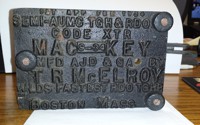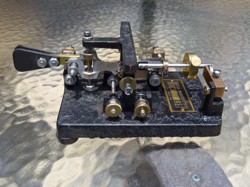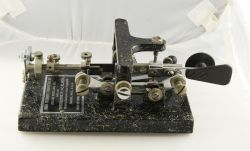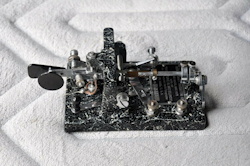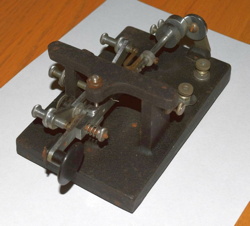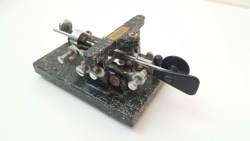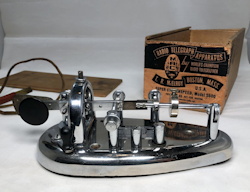McElroy Bugs
Ted McElroy is probably best known for holding the world record for copying morse code, which he set in 1939.
But McElroy is also known for his telegraph key designs. He started manufacturing telegraph keys, both bugs and straight keys, in 1934, and produced them until just before his death in 1963.
The desitinctive T-Bar design of his earlier bugs was actually to allow the operator to tip the key on its side so it could be used as a straight key. A special clip on the damper held the pendulum in place when this hand key operation was desired.
**On a sad note, the telegraph world lost a great man in February, 2016 with the passing of Tom French, W1IMQ. Tom was the definitive expert on the telegraph instruments of Ted McElroy. Author of "McElroy, World's Champion Radio Telegrapher", as well as "The Vibroplex Collector's Guide", Tom had a real passion for researching the history of the keys he loved so much. He will be sorely missed.
(Click on the pictures below to see larger versions of the photo)
1934 Model (1934)
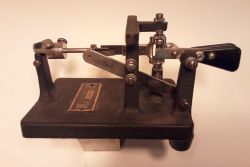 |
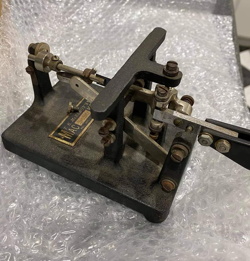 |
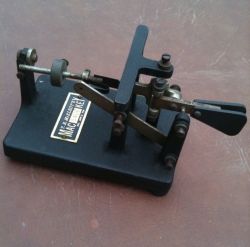 |
McElroy introduced his new Mac Bug in late 1934. The first advertisement appeared in Dec. 1934.
Notice that the dot contact is at the end of a long metal strip that comes up at an angle from the front support near the paddle.
Soon after introducing this key, he changed the design to put an upright support at the contact end of the strip. He also recalled many of the keys to be modified in this manner. Because of this, the 1934 Model is extremely rare. Probably only 2 or 3 are known to exist.
If you turn an early Mac key upside down and look under the base, you will see a lot of words and numbers that are cast into the base. Many people see the "9-34" and think this means they have a 1934 Mac, but all the early Mac key models had this same casting. So, you need to look at the contact strip to see if you have a genuine 1934 Mac.
Cast Base
This is the underside of the base on the early Mac bugs (1934-1936). Note the 9-34 date in the center. This is what causes people to mistakenly believe they have a rare 1934 Mac key !
1935 Model (1935)
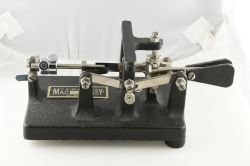 |
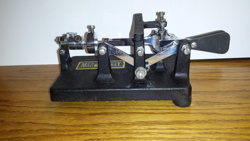 |
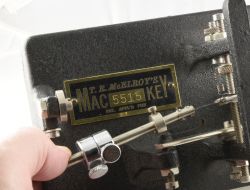 |
|---|
The 1935 Model is nearly identical to the 1934, except for the addition of the contact support post. There are 2 versions of this key, the "Deep Vee" and "Shallow Vee" which refers to the angle of the 2 contact strips on the left side of the key. The "Shallow Vee" keys are a bit earlier and much rarer than the "Deep Vee" keys.
1936 Model
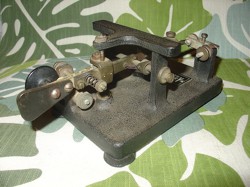 |
Again, similar to the 1934 and 1935 but the contact connection changed to a U-shaped strap. There were 2 versions of the lever pivot for this key. The 1936a version had a single piece pivot, while the 1936b pivot was made of a separate U-shaped piece that was riveted to the lever.
Mac Junior
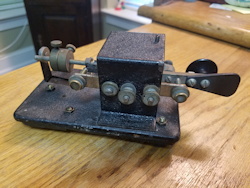 |
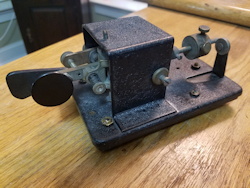 |
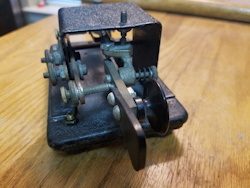 |
A big departure from the earlier designs. The base and housing are made of sheet metal and as you might expect, it was a horrible design. This makes the Mac Junior probably the 2nd rarest model.
Mac Navy Model CMK-26009 (1937)
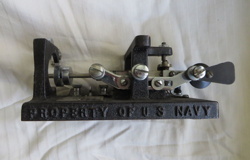 |
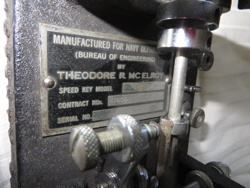 |
|---|
In 1937, McElroy designed a special bug for the US Navy. The key had a nameplate with the Navy designator CMK-26009 and the side of the base was cast with "Property of the US Navy". Although over 200 were made, only 4 are known to exist today.
1937 Civilian Model
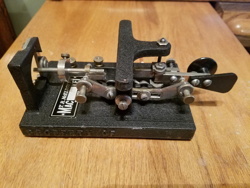 |
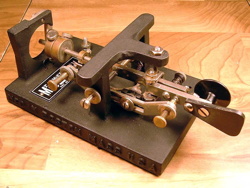 |
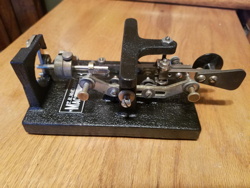 |
McElroy also made the 1937 model for civilian use. The first version used the same cast base as the Navy model, but they ground off the words "U.S. Navy" from the side of the base. After this they changed the casting so the lettering on the side read "MFG IN BOSTON MASS USA". The last version of the key removed all lettering from the base.
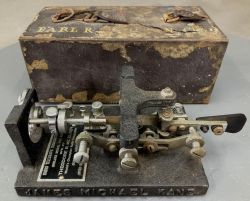 |
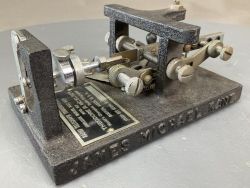 |
Above is a custom made 1937 civilian model bug that has the owner's name cast into the base !
1938 Model
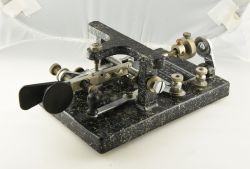 |
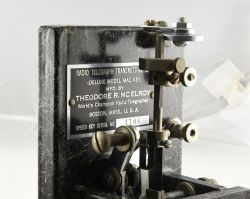 |
The 1938 Mac was available in either the Standard Model with black crackle paint finish, or the Deluxe Model with faux "marbleite" finish. The Deluxe Model had a circuit closer.
1939 Model
Very similar to the 1938 but with wider risers for the contact supports.
Model 500 (1940)
The Model 500 was a cost reduced version of the 1938 standard model. No nameplate, no circuit closer. Black crackle paint finish. Kind of a plain looking key.
Model 600 (1940)
 |
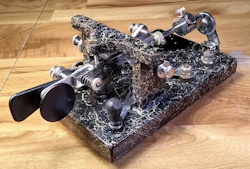 |
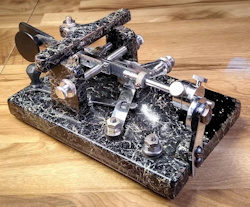 |
The Model 600 was a cost reduced version of the 1938 Deluxe model. Same as the Model 500 but in the marbleite finish. Had 2 ID decals on it. Also had a circuit closer. Often the decals are missing because they were water soluable and peeled off easily.
Model A-400
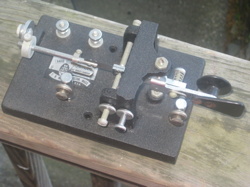 |
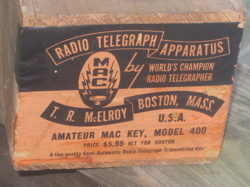 |
|---|
No more T-Bar frame. No circuit closer. Another plain looking key. Fairly scarce. Also pictured is one of the famous Mac-Key wooden boxes.
Model P-500 (1941)
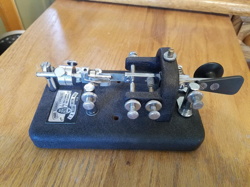 |
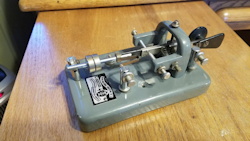 |
The Model P-500 did away with the T-Bar frame and used an upside-down U-shaped frame. The base was more rounded unlike previous bug models. (WB6BEE Collection).
Model S-600 (1941)
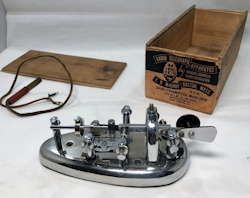 |
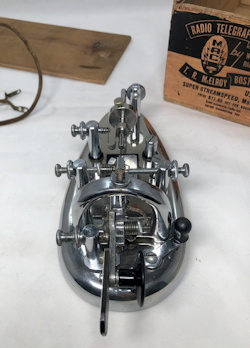 |
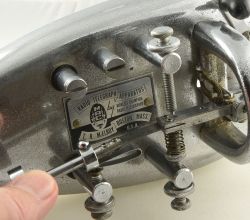 |
Also called the Super Stream-Speed. Kind of looks like a laundry iron. McElroy's first all chrome bug, which was surprising considering he never liked chrome keys. He said they caused too much glare.
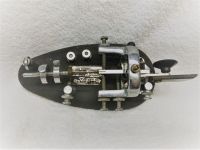 |
A rare version of the Super Stream-Speed bug in black crackle finish.
Model CP-500 & Model 500-742 (1942)
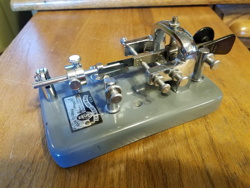 |
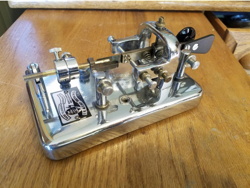 |
The CP-500 was the same as a P-500 but with a chrome-plated frame and painted base. The Model 500-742 was a P-500 with chrome plated frame and base. (WB6BEE Collection)
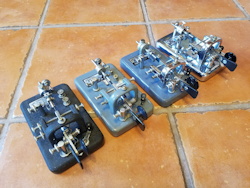 |
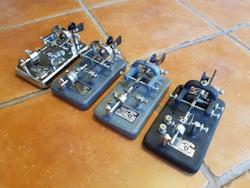 |
All 4 versions of the Mac P-500 (WB6BEE Collection)
Telegraph Apparatus Co. Bugs (Ted McElroy's Chicago Partnership):
Telegraph Apparatus CP-500 & CP-800
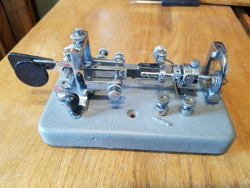 |
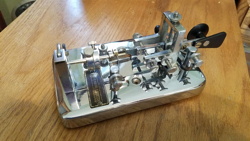 |
The Telegraph Apparatus Co. (TACo) bugs were similar to the regular Model 500 except that the frame and damper were more like Vibroplex style and the nameplate indicated TACo rather than McElroy. The TACo CP-500 had a painted base, while the CP-800 was chrome plated all over. (WB6BEE Collection)
Telegraph Apparatus CP-510 and CP-810
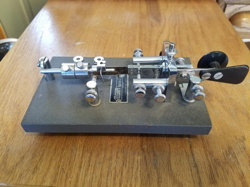 |
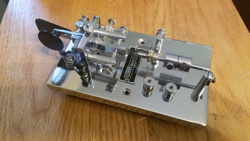 |
The CP-510 and CP-810 were commonly known as the "Hole in the Wall" bugs, because the frame was a simple metal plate with a large hole in the middle for the lever. The CP-510 had a gray crackle paint base finish, while the CP-810 was chrome plated. (WB6BEE Collection)

